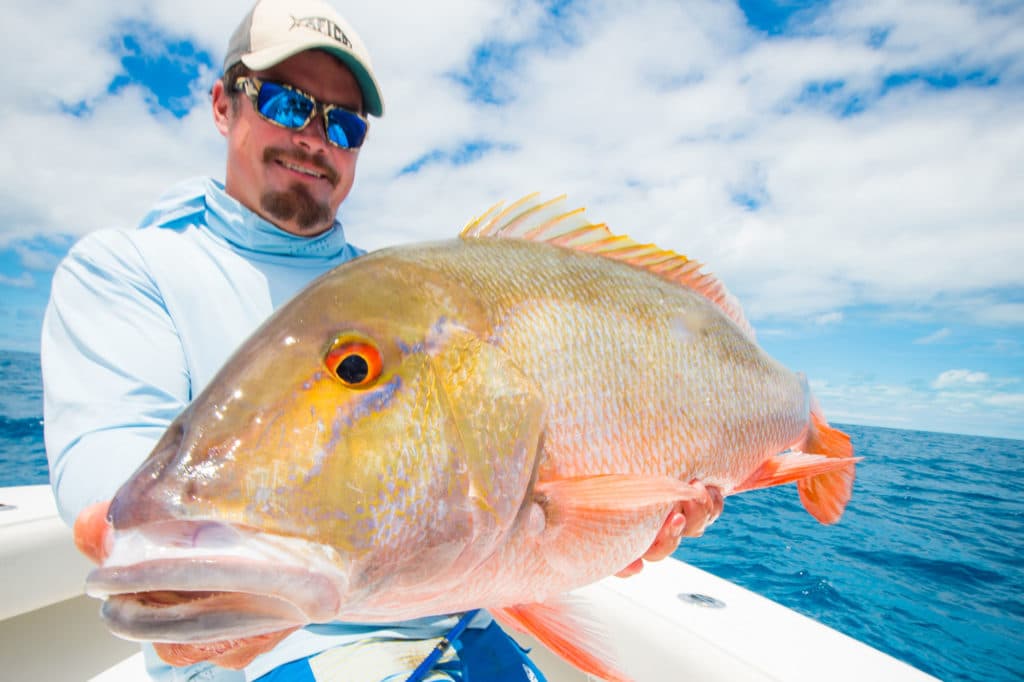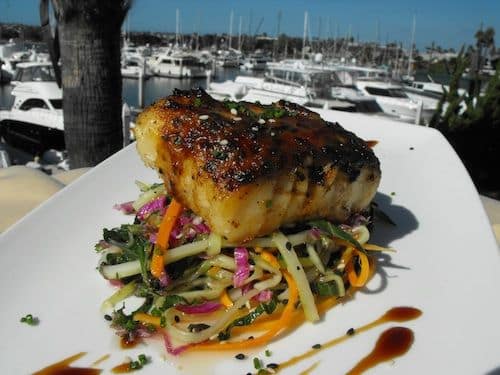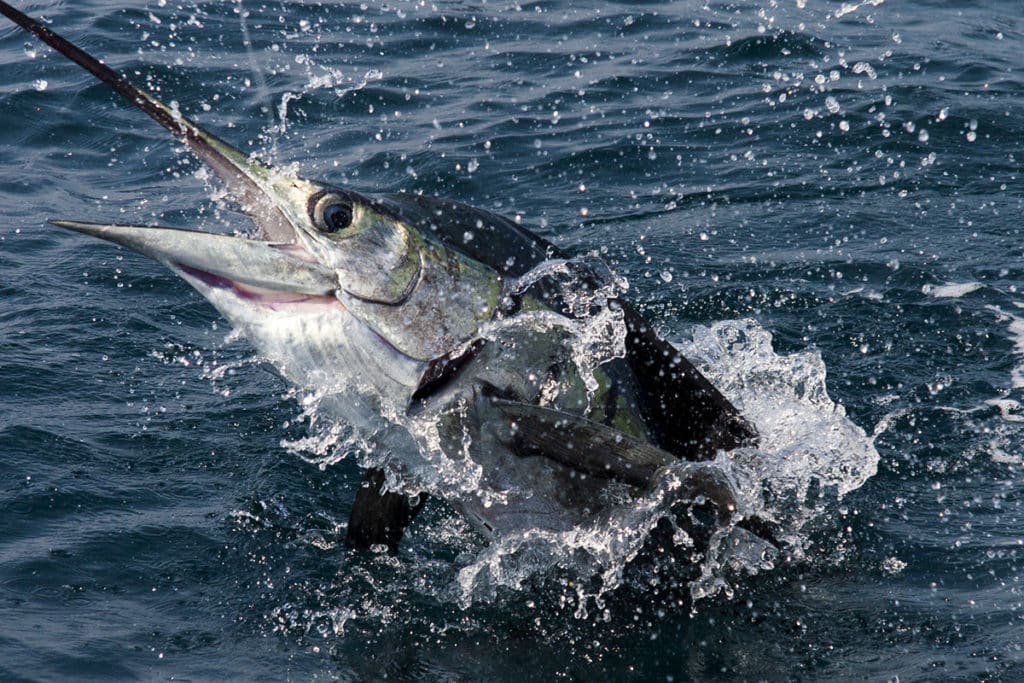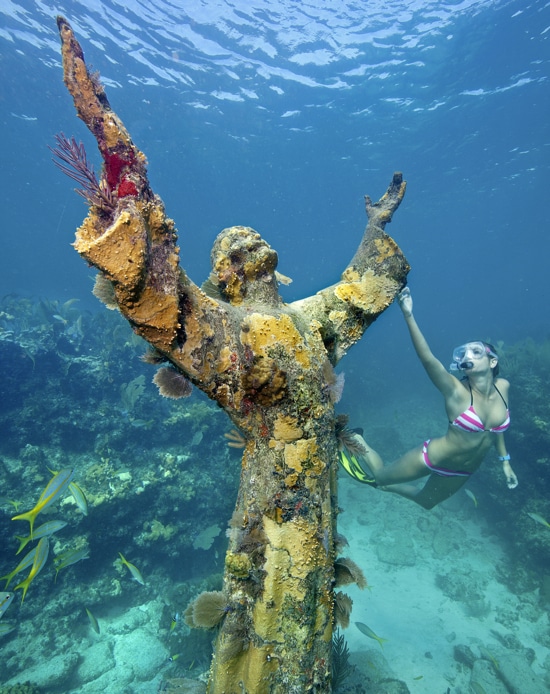May Fishing in the Florida Keys

From December to June, delicious and hard-fighting bottom species like red grouper and mutton snapper are available to anglers. (Be mindful of the seasons in 2017.) The full-moon spawn in May attracts masses of muttons, followed in June by their movement into shallow water. In the Gulf, a falling tide is best, says Capt. Mike Weinhofer, of Compass Rose Charters. Productive structures are the ledges or small rock outcroppings over flat-bottom areas. Key West has the Bar, which is 45 feet deep on top, but drops to 110 feet over just 50 yards.
“My favorite place to catch muttons is down to the west [near the Dry Tortugas], in less than 20 feet of water, using live ballyhoo on spinning rods with some backbone,” he says. “I use Fin-Nor spinners with 30-pound Sufix 832 braid, tipped with 30- to 40-pound fluoro leader tied to a small white bucktail.
“The mutton and grouper fishing tend to get better the farther west you go,” says Weinhofer, who adds that one fishery few anglers know about is the many true American red snapper off Key West. “The numbers of red snapper are staggering — a totally underutilized fishery that’s catch-and-release for all but a few days a year,” he says. “I love fishing around the Dry Tortugas for bottom species. It’s an untouched wonderland.”
A Tasty Bottomfish Recipe
Chef Steve Black details an easy recipe to learn and prepare for groupers and snappers. His preference is for cod or salmon, but bottom species work great too. This recipe has two parts — slaw preparation and the fish. The recipe serves four.

INGREDIENTS (Part 1)
- 1 carrot, peeled, julienned
- 1 English cucumber, peeled, de-seeded, julienned
- 2 stalks celery, julienned
- 1 bunch kale, chiffonade cut
- 2 TBSP ponzu vinaigrette (any brand)
- 1 TBSP rice wine vinegar
- 1 TBSP olive oil
INSTRUCTIONS: After preparing all of the vegetables, mix together in a bowl and check seasoning. Add kosher salt and fresh black pepper if needed (though the ponzu vinaigrette dressing should season it alone). Then store covered in the refrigerator.
INGREDIENTS (Part II)
- 4 grouper or snapper fillets
- 2 TBSP extra virgin olive oil
- 2 TBSP sesame seed oil
- 2 TBSP chopped chives
- 1 TBSP seasoning salt
- 2 TBSP mayonnaise
- 2 TBSP red miso paste (any flavor miso will work)
- 1 TBSP ponzu vinaigrette (any brand)
- 2 TBSP chopped chives
INSTRUCTIONS:
- Preheat oven to 400F.
- Mix together the olive oil, sesame oil and 1 TBSP of the chopped chives.
- In another bowl mix the mayonnaise, red miso paste and ponzu vinaigrette to smooth out any lumps. Add the remaining 1 TBSP of chopped chives to the mayo mix.
- Season the grouper on all sides with a little seasoning salt.
- Spoon some of the sesame oil mixture on top of all fish fillets and place on roasting pan.
- Place fish in the oven and roast for 10 minutes until the fish is almost cooked through.
- Remove from oven and spread an even coating of the red miso mayonnaise mix on each fillet.
- Return to oven to cook an additional 5 minutes or until the fish reaches an internal temperature of 145F. (I personally like to remove the fish when it hits 140F or so and let the carry-over cooking hit 145F after a few minutes while letting the fish rest.)
- Plate up the slaw mix ad top with the grouper. Enjoy!
About the Chef: Steve Black attended Johnson & Wales University in Providence, Rhode Island, and began his hotel career at the Sheraton Boston Hotel & Towers in 1984. In 1990, Chef Black traveled abroad to Strasbourg, France, where he had the opportunity to work with several 5-Star Michelin Chefs. Returning to the U.S. in 1992, he moved to San Diego, California, and joined the culinary teams at the La Costa Resort & Spa and at the Hyatt La Jolla Aventine. In 1993, he became the Executive Chef at the Sheraton Hotel & Marina on Harbor Island. During his off time, Steve fishes the offshore waters from San Clemente Island down to Ensenada and everywhere in between from his 25-foot Boston Whaler Revenge.
The Sailfish Season Continues
The Florida Keys winter and spring sailfishery is hot even during slow years, making the fishery incredibly dependable. In 2012, Capt. Scott Stanczyk recorded an epic sailfish bite, releasing 47 sails in a single day out of Bud N’ Mary’s in Islamorada. In 2017, Team Indigenous won the 27th annual Cheeca Lodge Presidential Sailfish Tournament in January, releasing eight sailfish. Team Relentless took second place, scoring seven sails. The 2017 year might be considered a down year in terms of numbers, but there are still plenty of fish to be caught into May.

From Stuart north, anglers generally troll ballyhoo; to the south, live baits fished under kites or slow-trolled are the norm. At times, expect exciting pitch-baiting opportunities too. The run to fish is often within 10 miles, and fish are sized from 30 to 40 pounds.
Capt. Dean Panos keeps as many baits in the water as possible when kite-fishing, especially after hooking and fighting a fish. When Panos kite-fishes, he typically includes three baits on two kites. Once there’s a hookup, other team members concentrate on keeping their baits in the water while the angler is fighting his fish.
Explore the State Parks in the Keys
Florida state parks offer some of the best fishing, boating and kayaking in the Keys. A couple of the parks have worldwide recognition, while others don’t get nearly as much attention. Below, three Florida Keys state parks that are friendly to fishermen. Check them out the next time you travel the Keys by water or road.

John Pennekamp Coral Reef State Park
The first undersea park in the United States, Key Largo’s John Pennekamp Coral Reef State Park is located at MM 102.5 and encompasses about 70 nautical square miles. The park was added to the National Register of Historic Places on April 14, 1972.
Canoeing, kayaking and salt-water fishing in designated areas. The park offers 2.5 miles of marked mangrove wilderness and tropical hammocks in upland areas. There are three designated swimming areas with beaches on Largo Sound. A beach wheelchair is available upon request.
Fishing is permitted in designated areas in accordance with Florida state law. Spearfishing, possession of spearfishing equipment, and collection of tropical fish is prohibited inside the park.
Lignumvitae Key Botanical State Park
At 287 acres and festered with tropical hardwood hammock, Lignumvitae Key Botanical State Park offers a rare look at island-style living in the Upper Keys in the 1930s. The tiny island is located about a mile west of the Overseas Highway at MM 78.5 in Islamorada. Not surprisingly, the park is accessible only by boat.
The island is open Thursday through Monday from 8 a.m. to 5 p.m. with an entrance fee of $2.50 per person. Guided tours are offered from December through April, Friday through Sunday.
Anglers can fish for a variety of species, including bonefish on the flats, tarpon in the channels, snapper, and Spanish mackerel. Supposedly, snook are also found in the area.
Curry Hammock State Park
Curry Hammock State Park, in Marathon, offers the largest uninhabited piece of land between Key Largo and Big Pine Key. The park is located at 56200 Overseas Highway, MM 56.2.
Curry Hammock is a secret hot spot for shallow-water fishing. When conditions are windy, the park’s oceanfront is a popular bet. The park features beautiful mangrove creek and miles of pristine coastline, and preserves essential Keys native ecosystems that include mangrove swamp, rockland hammocks and seagrass beds.
The flats nearby often hold permit and bonefish, and the channel alongside the park produces sharks and snapper.
(Information provided by The Florida Keys and Key West and Florida State Parks)








